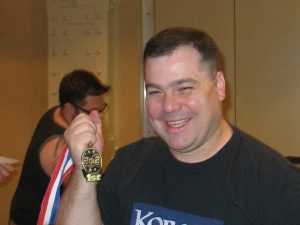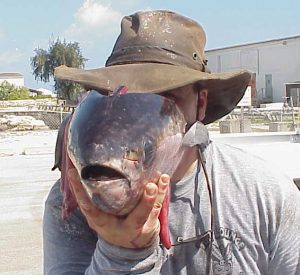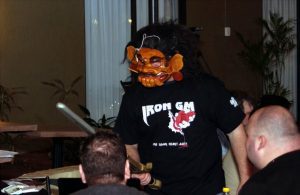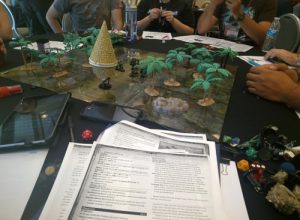 Welcome back to another interview that celebrates the upcoming 10th anniversary of Open Design! This time, we talk to Ben McFarland.
Welcome back to another interview that celebrates the upcoming 10th anniversary of Open Design! This time, we talk to Ben McFarland.
When you look around for the kobold minion who can bench press the development of book with one hand, double-check the numbers on a stat block with another, all the while scribbling out an encounter with a pen stuck between his toes, Ben McFarland is that kobold. He and his team produced an ENnie-winning product, Streets of Zobeck. in 2012, and he’s only picked up steam since that time, collaborating on Deep Magic, Southlands, and Tome of Beasts, among other products.
Q: When I think of Ben McFarland, I think of this guy with a deep reservoir of energy who does amazing things on behalf of KP at GenCon. And that only scratches the surface. But let’s start there: What is your convention experience like—run through the things you do, sharing what is most enjoyable—and why is what happens at conventions important to KP?
When I get to the convention on Wednesday, I like to check-in and see if I can get a Fat Tire ale—I grew to love them when I lived in Colorado, and I can’t get them in New York, so I try to enjoy them while I can at Indianapolis. For me, GenCon represents the holy days of the RPG people, my people, and this is a great time to see people I usually only get to engage online. I try to make the most of the chance and talk to as many folks as I can, see as many things as I can, and, of course, play some games. Conventions are important for KP for different reasons over the years. At first, we were guerrilla flyer ninjas for Open Design projects, and then we were talking up Kobold Quarterly. Now we’re more playtesting and sharing adventures from Kobold Press, plus exposing people to the awesome world of Midgard. Sharing that with the wider world is really cool.
Q: You have a gold ENnie for adventure of the year, Streets of Zobeck, for which you were lead designer in 2012. The scenario you wrote, “Everyone Lies” is a search for a thug’s girlfriend, in which we get to meet much of the seedy and undead underbelly of Zobeck. What were the challenges of designing Streets, in general, and “Everyone Lies,” specifically?
Streets was tough, because we were designing it “backward,” in a sense. We created the NPCs, the places, the magic, and then worked together to decide what stories we’d put into that space. It was great to see how people embraced the model and it made a difference in the final product. Streets was intended to be a collection of noir tales, and that made us cognizant of the portrayals of characters, trying to meet the style but be considerate. I’d like to think we carried that consideration forward into other projects, like Midgard Tales.
 Q: I’ve heard that you have a passion for Ars Magica. How does that interest intersect with KP’s Midgard?
Q: I’ve heard that you have a passion for Ars Magica. How does that interest intersect with KP’s Midgard?
I love the possibility of taking the bits of our mythic world and warping them into the right level of fantasy for Midgard. I love that I can look at Midgard and see a crazy magical version of the world I recognize, that the blur filter flips back and forth so easily for me. I could run things in Midgard forever now, realizing that, and I love it.
Q: Another hat you’ve worn is developer. Specifically, you were developer for Journeys to the West, which is all about pirates and discovery and uncharted islands. Walk us through that project and what made it special.
That was a great project because it pushed our world-building boundaries, and it gave us this great nebulous space that was defined but shifting, with some awesome elements I still like playing with sea titans, the leviathan, and floating islands drifting on the waves. Many of the patrons for Streets carried over to Journeys and I made some great professional relationships from that project. We followed a very similar model to Streets, crafting the islands, the spaces and magic, the monsters and races, and then looked at the adventures we wanted in that space. It came together really well, but it was probably the last project I worked on where we overdelivered in a massive way. We were transitioning from the informal model we used in the forums and livejournal to the way we run projects from Kickstarter.
 Q: Southlands must be one of the biggest, most daunting collaborations KP has done. You labored primarily with Brian Suskind on it. What a gorgeous campaign setting that became! Talk about collaboration, the task of deconstructing monster statistics, and delivering on the Southlands concept.
Q: Southlands must be one of the biggest, most daunting collaborations KP has done. You labored primarily with Brian Suskind on it. What a gorgeous campaign setting that became! Talk about collaboration, the task of deconstructing monster statistics, and delivering on the Southlands concept.
I spent a lot of time in books about Africa, from the Maghreb to Ethiopia to the Swahili Coast to Great Zimbabwe to the Mali Empire. Southlands was my third RPG book set in an Africa-like setting, and it benefits from the crazy amount of research we nosed through working on all them. Brian and I talked practically daily, batting ideas back and forth, twisting bits up and discussing how to present particular elements. It was more about the cultures, to create this rich expanse of adventure and exploration, where you found elements that felt ancient and fresh at the same time. I think we succeeded. There were a few monsters we wanted to make sure showed up, certainly, but we wanted the people to be primary draw.
Q: What drew you into the Kobold Press sphere in the first place? Do you have a fun or interesting story about working with or interacting with Wolfgang you’d like to share?
I started off as a senior patron and playtester for the Empire of the Ghouls project—that’s the secret key to influencing projects, by the way. Playtesters hold the secret radio to a designer’s inner spaces, able to send messages about how a project works or doesn’t work before it is unleashed on the world. That’s a great opportunity hidden in plain sight. But I found out about Open Design from an offhand comment from a GM I respected on one of the Living Greyhawk Yahoo! lists. Once I saw what it was—this master’s course in RPG design, this community where we would all riff off each other and the best parts would then be blended back into the original—I was hooked. I was on every project I could feasibly handle after that, and backed them all. I told Wolfgang very early on—you need minions. The rest is history.
 Q: Let’s talk Deep Magic. How is producing a spellbook accessory different than other RPG writing/designing? What are its unique features?
Q: Let’s talk Deep Magic. How is producing a spellbook accessory different than other RPG writing/designing? What are its unique features?
Making a book like Deep Magic is more about making crazy options about a thousand hooks of inspiration and about a hundred different power levels all jammed together in between two covers. It’s about exploring specialties and topics with the eye of someone obsessed with that particular focus. What stories do the spells inspire? What kind of magicians and priests would use this spell and how would they use it? Magic is all about unique, and in many ways, it is a black art. Designing spells had no reference but system familiarity for a long, long time, and because of that, yes, designers often see things from different perspectives. Personally, I have some elements from an old Dragon article I’ve internalized, aspects of comparison with touchstone spells at each level. I know I also tend toward more magic-heavy games, and so if I find myself thinking twice about a spell’s effect, even after comparing it to others at a similar level, I talk it over with a couple of peers and consider kicking it up a level. But games have different power levels the way they have different GMs, and what’s high-powered for your game might be under-powered for another game. I think that’s important to keep in mind. I think a lot about magic systems.
Q: What elements of OD/KP/Midgard are your favorite? What is your favorite contribution to the setting and products? And explain why.
I love the Wasted West, Ankeshel, Bemmea, the Empire of the Ghouls, and, of course, the Southlands. I love the Wasted West knowing the twisted magics can explain away whatever happens there. I love Ankeshel for what it was. I love Bemmea for the promise it offers, the seed of a possible second magical empire. I love the Empire of the Ghouls for the dark mirror it holds up to the surface; the ghouls know they’re monsters, while the people above them often turn a blind eye to terrible behaviors all around them. Of all the products I’ve worked on, I think it’s a draw between Midgard Legends and Southlands. Southlands is just so much, but in the same vein, Midgard Legends expands on the mythology of the world, giving people more of the details to create immersive games. When your players invest in the world, wanting more detail about the fantasy place you’re sharing with them, that’s a win.
Q: Outside of RPGs, what are your interests and activities? What is it about them you find particularly engaging?
I’m a father of two small children, so I don’t have a ton of free time, but I try to make my interests into writing projects, or gain new interests from my projects. I love bits of weird, what-if history, I love history in general and the Roman Empire in particular. I love beer, and Halo, and fencing saber, but I get to do none of those things as much as I would like anymore. More than any of it, I love RPGs, and I try to read as many of them as I can, and play them whenever I have a chance.
 Q: As a gamer, do you primarily GM or run a PC? Got any favorite scenarios/characters? Any war stories you want to share?
Q: As a gamer, do you primarily GM or run a PC? Got any favorite scenarios/characters? Any war stories you want to share?
I’m often a GM, but I’m also very fortunate to play with a troupe who runs Ars Magica a lot, and so we trade who is the GM on a regular basis. Right now, we’re giving Trail of Cthulhu a try, and I’m playing a Great War veteran turned acquisitions house muscle. I run a pick-up game of fifth edition at my son’s swim practice for two hours a week, a once-a-week lunch game of Pathfinder, and I’m completing an 8-week enrichment program for my son’s school, where I’ve been running Adventure Maximus for the kids. As a GM, one of my favorite scenarios to run has been Gravebinder’s Daughter, because the sandbox aspect of it. The above-ground dungeon elements make it very interesting and fun. I won’t bore you with details about Acumenis, my berber Bonisagus in Cumbria, circa 1163 AD, though. The toughest game to run for me had to be GenCon 2013? I had a voice somewhere between crushed gravel and a three-pack-a-day smoker, and I was trying to record a play of Grandmother’s Fire. It took no effort to do a good Baba Yaga.
Q: To conclude each interview, I’m asking each person to think about something fantastic or wonderful (or scary) from all the KP products that would make an awesome gift for Wolfgang. Basically, let’s fill up Wolfgang’s garage with weird and wonderful stuff. What gift would you choose and why?
Oh my…hmmmm, what would I send him? Honestly? I think I’d send him an airship. That was the first article he gave me the green light to write for Kobold Quarterly, and I had a blast with them. We incorporated them into Halls of the Mountain King, and Midgard Tales, and if I’ve been given the brass ring to park anything I like at his garage, I think he’d most appreciate a fine airship and directions to get to Midgard to go with it.

Thanks for the chance to be interviewed, Troy!
The pleasure was all mine.
I enjoyed learning more about Ben. I learned so much from him and the other designers on Streets of Zebeck and other projects. Its great to work with such creative minds.
Cheers!
JWT
Ben does wonderful work! He is absolutely one of the best!
Another great interview!
Ben is a great guy, always willing to help out and contribute to a friends project.
Also, I learned at GenCon 2015 that he’s got a great stealth bonus. But we don’t need to go into detail. :P